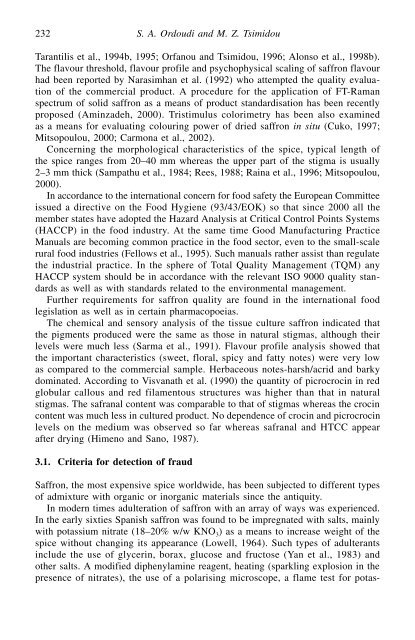Production Practices and Quality Assessment of Food Crops. Vol. 1
Production Practices and Quality Assessment of Food Crops. Vol. 1
Production Practices and Quality Assessment of Food Crops. Vol. 1
You also want an ePaper? Increase the reach of your titles
YUMPU automatically turns print PDFs into web optimized ePapers that Google loves.
232 S. A. Ordoudi <strong>and</strong> M. Z. Tsimidou<br />
Tarantilis et al., 1994b, 1995; Orfanou <strong>and</strong> Tsimidou, 1996; Alonso et al., 1998b).<br />
The flavour threshold, flavour pr<strong>of</strong>ile <strong>and</strong> psychophysical scaling <strong>of</strong> saffron flavour<br />
had been reported by Narasimhan et al. (1992) who attempted the quality evaluation<br />
<strong>of</strong> the commercial product. A procedure for the application <strong>of</strong> FT-Raman<br />
spectrum <strong>of</strong> solid saffron as a means <strong>of</strong> product st<strong>and</strong>ardisation has been recently<br />
proposed (Aminzadeh, 2000). Tristimulus colorimetry has been also examined<br />
as a means for evaluating colouring power <strong>of</strong> dried saffron in situ (Cuko, 1997;<br />
Mitsopoulou, 2000; Carmona et al., 2002).<br />
Concerning the morphological characteristics <strong>of</strong> the spice, typical length <strong>of</strong><br />
the spice ranges from 20–40 mm whereas the upper part <strong>of</strong> the stigma is usually<br />
2–3 mm thick (Sampathu et al., 1984; Rees, 1988; Raina et al., 1996; Mitsopoulou,<br />
2000).<br />
In accordance to the international concern for food safety the European Committee<br />
issued a directive on the <strong>Food</strong> Hygiene (93/43/EOK) so that since 2000 all the<br />
member states have adopted the Hazard Analysis at Critical Control Points Systems<br />
(HACCP) in the food industry. At the same time Good Manufacturing Practice<br />
Manuals are becoming common practice in the food sector, even to the small-scale<br />
rural food industries (Fellows et al., 1995). Such manuals rather assist than regulate<br />
the industrial practice. In the sphere <strong>of</strong> Total <strong>Quality</strong> Management (TQM) any<br />
HACCP system should be in accordance with the relevant ISO 9000 quality st<strong>and</strong>ards<br />
as well as with st<strong>and</strong>ards related to the environmental management.<br />
Further requirements for saffron quality are found in the international food<br />
legislation as well as in certain pharmacopoeias.<br />
The chemical <strong>and</strong> sensory analysis <strong>of</strong> the tissue culture saffron indicated that<br />
the pigments produced were the same as those in natural stigmas, although their<br />
levels were much less (Sarma et al., 1991). Flavour pr<strong>of</strong>ile analysis showed that<br />
the important characteristics (sweet, floral, spicy <strong>and</strong> fatty notes) were very low<br />
as compared to the commercial sample. Herbaceous notes-harsh/acrid <strong>and</strong> barky<br />
dominated. According to Visvanath et al. (1990) the quantity <strong>of</strong> picrocrocin in red<br />
globular callous <strong>and</strong> red filamentous structures was higher than that in natural<br />
stigmas. The safranal content was comparable to that <strong>of</strong> stigmas whereas the crocin<br />
content was much less in cultured product. No dependence <strong>of</strong> crocin <strong>and</strong> picrocrocin<br />
levels on the medium was observed so far whereas safranal <strong>and</strong> HTCC appear<br />
after drying (Himeno <strong>and</strong> Sano, 1987).<br />
3.1. Criteria for detection <strong>of</strong> fraud<br />
Saffron, the most expensive spice worldwide, has been subjected to different types<br />
<strong>of</strong> admixture with organic or inorganic materials since the antiquity.<br />
In modern times adulteration <strong>of</strong> saffron with an array <strong>of</strong> ways was experienced.<br />
In the early sixties Spanish saffron was found to be impregnated with salts, mainly<br />
with potassium nitrate (18–20% w/w KNO 3) as a means to increase weight <strong>of</strong> the<br />
spice without changing its appearance (Lowell, 1964). Such types <strong>of</strong> adulterants<br />
include the use <strong>of</strong> glycerin, borax, glucose <strong>and</strong> fructose (Yan et al., 1983) <strong>and</strong><br />
other salts. A modified diphenylamine reagent, heating (sparkling explosion in the<br />
presence <strong>of</strong> nitrates), the use <strong>of</strong> a polarising microscope, a flame test for potas-

















